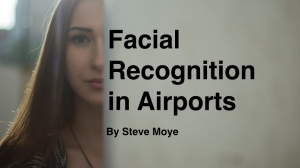 Remember the first time you posted a photo on Facebook, and the algorithm figured out who you were trying to tag before you could even type in their name? Blew your mind, right? Well, facial-recognition technology has only gotten more sophisticated, and I recently read an article about how it’s on the path to being used in airports. The TSA has already begun testing facial recognition systems at the Dulles and JFK Airports. Face-reading check-in kiosks will be appearing at both Ottawa International and London Heathrow later this year, comparing faces captured at security screenings. A new project called Biometric Exit is now set to bring this system to every international airport in the US.
Remember the first time you posted a photo on Facebook, and the algorithm figured out who you were trying to tag before you could even type in their name? Blew your mind, right? Well, facial-recognition technology has only gotten more sophisticated, and I recently read an article about how it’s on the path to being used in airports. The TSA has already begun testing facial recognition systems at the Dulles and JFK Airports. Face-reading check-in kiosks will be appearing at both Ottawa International and London Heathrow later this year, comparing faces captured at security screenings. A new project called Biometric Exit is now set to bring this system to every international airport in the US.
Biometric Exit would use facial matching systems to identify every visa holder as they leave the country. Here’s how it would work: passengers would have their photos taken immediately before boarding, which would be matched with the passport-style photos provided with the visa application to see whether or not the visitor entered the country illegally. While it’s currently being tested on a single flight, the Trump administration has plans to expedite its usage until it’s being used for every flight and border crossing in the US. Speaking at the Border Security Expo last week, US Custom and Border Protection’s Larry Panetta spoke of the importance of facial recognition.
Biometric Exit, or at least some form of it, has been discussed for decades. However, it’s only recently that facial recognition has been named as the method of choice. Fingerprint and iris-based systems have been named as well, but ultimately facial recognition has been preferred, since it’s the easiest. Although Customs and Border Protection agents take photos and fingerprints from every visa holder entering the country, no such measures exist to see if somebody’s left the country before their visa expires. According to Homeland Security, roughly half a million people overstay their visas to the US each year, although they can’t determine who these people are without any verifiable exit process. This is where the Biometric Exit would come in. Trump has made the program a large part of his aggressive border security policy.
For this system to work, it will require a robust method for checking passengers’ faces against outside datasets, yet as that system is shared with more agencies, it might be used for a lot more. Such technology could be shared with land borders and even private airlines. There are still some technical challenges, and it’s as of yet unclear how well the system works with existing in-airport surveillance system,s but sharing the backend with CBP could make the system a whole lot more efficient. However, such systems raise a lot of difficult civil rights questions, especially if the FBI is integrated into this system.
While the Customs and Border Protection said that Biometric Exit would be meant to benefit travelers and still not disrupt travel, concerns have been raised about racial bias. American facial recognition systems are typically trained on mostly white subjects, so they’re a lot less accurate when scanning other races. If such a bias isn’t corrected, then it could be a major civil rights issue, especially since visa holders tend to be younger and less white than the average US population. As the program’s growth is expedited by Trump, such questions become more and more urgent.
